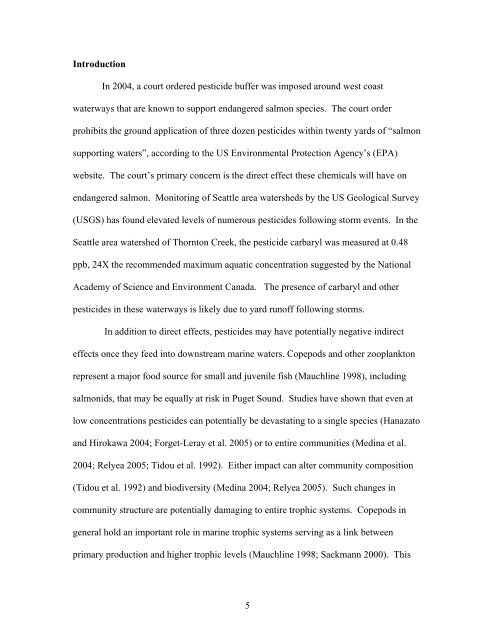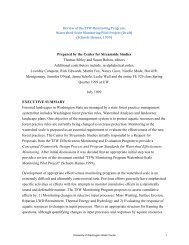Brianna Fox.pdf
Brianna Fox.pdf
Brianna Fox.pdf
You also want an ePaper? Increase the reach of your titles
YUMPU automatically turns print PDFs into web optimized ePapers that Google loves.
Introduction<br />
In 2004, a court ordered pesticide buffer was imposed around west coast<br />
waterways that are known to support endangered salmon species. The court order<br />
prohibits the ground application of three dozen pesticides within twenty yards of “salmon<br />
supporting waters”, according to the US Environmental Protection Agency’s (EPA)<br />
website. The court’s primary concern is the direct effect these chemicals will have on<br />
endangered salmon. Monitoring of Seattle area watersheds by the US Geological Survey<br />
(USGS) has found elevated levels of numerous pesticides following storm events. In the<br />
Seattle area watershed of Thornton Creek, the pesticide carbaryl was measured at 0.48<br />
ppb, 24X the recommended maximum aquatic concentration suggested by the National<br />
Academy of Science and Environment Canada. The presence of carbaryl and other<br />
pesticides in these waterways is likely due to yard runoff following storms.<br />
In addition to direct effects, pesticides may have potentially negative indirect<br />
effects once they feed into downstream marine waters. Copepods and other zooplankton<br />
represent a major food source for small and juvenile fish (Mauchline 1998), including<br />
salmonids, that may be equally at risk in Puget Sound. Studies have shown that even at<br />
low concentrations pesticides can potentially be devastating to a single species (Hanazato<br />
and Hirokawa 2004; Forget-Leray et al. 2005) or to entire communities (Medina et al.<br />
2004; Relyea 2005; Tidou et al. 1992). Either impact can alter community composition<br />
(Tidou et al. 1992) and biodiversity (Medina 2004; Relyea 2005). Such changes in<br />
community structure are potentially damaging to entire trophic systems. Copepods in<br />
general hold an important role in marine trophic systems serving as a link between<br />
primary production and higher trophic levels (Mauchline 1998; Sackmann 2000). This<br />
5

















